

Sarus Crane

Sarus Crane
The Sarus Crane, Grus antigone is a large crane that is a resident breeding bird with disjunct populations that are found in parts of the Indian Subcontinent, Southeast Asia and Australia. Standing at a height of up to 1.8 m, the tallest of the flying birds, they are conspicuous and iconic species of open marshlands. Their numbers have declined greatly in the last century and it has been estimated that the current population is only 10% or even just 2.5% of the numbers that existed in the 1850s. The stronghold of the species is in India, where it is traditionally revered and has adapted to live in close proximity with humans. The species has been extirpated in many parts of the large range.
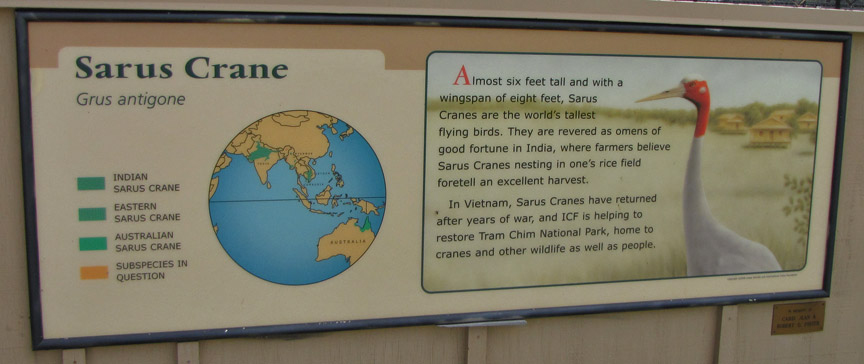
Adults birds are very large with grey wings and body; a bare red head and part of the upper neck; a whitish crown; and a long dark pointed bill. In flight, the long neck is held straight, unlike a heron that folds it back, and the black wing tips can be seen; their long red or pink legs trail behind them. They have a grey ear covert patch, a reddish iris and a greenish grey bill. Juveniles have a pinkish base to the bill and the head is fully feathered and grey. The bare head and neck has red skin that is brighter during the breeding season. The skin is rough and covered by papillae and a narrow area around behind the head is covered by black bristly feathers. The sexes do not differ in colour although males are larger on average than females; Indian males can attain a maximum height of approximately 200 cm (6.6 ft), with a wingspan of 250 cm (8.5 ft), making them the world's tallest living flying bird. The average weight of nominate race individuals is 6.8-7.8 kg, while five adult sharpii averaged 8.4 kg. Across the range, weight can vary from 5 to 12 kg (11-26 lbs), height typically from 115 to 167 cm (45-69 in) and the wingspan from 220 to 280 cm (87-110 in). Birds from Australia tend to be smaller than birds from the north.

In Australia, the Sarus can easily be mistaken for the more widespread Brolga.
The Brolga has the red colouring is confined to the head and not extending into
the neck.
This species was originally described by Linnaeus under the genus Ardea along
with the larger herons.

This species has several subspecies some of which are no longer recognized while
some are believed to be extinct. The nominate race from India is the largest and
in the east from Myanmar it is replaced by race sharpii extending into the
Southeast Asian islands. The nominate form from the Indian subcontinent is well
marked and differentiated by having a white collar below the bare head and upper
neck, and white tertiary remiges. The race in Australia, initially placed in
sharpii (also sometimes spelt sharpei but amended to conform to the rules Latin
grammar) has been separated and named as the race gilliae (sometimes spelt
gillae or even gilli). The Australian race was designated in 1988 (the species
itself was discovered in Australia only in 1969 and was initially considered to
be a recent immigrant, however native Australians differentiate between the
Sarus and the Brolga. Natives call the Sarus "the crane that dips its head in
blood".) by Schodde on the basis of its distinctively darker plumage and large
grey patch of ear coverts. This race is also the most recently diverged one with
an estimated 3000 generations of breeding within Australia. An additional
subspecies luzonica has been suggested for the race that was found in the
Philippines and now extinct. It may be synonymous with either gilliae or
sharpii.
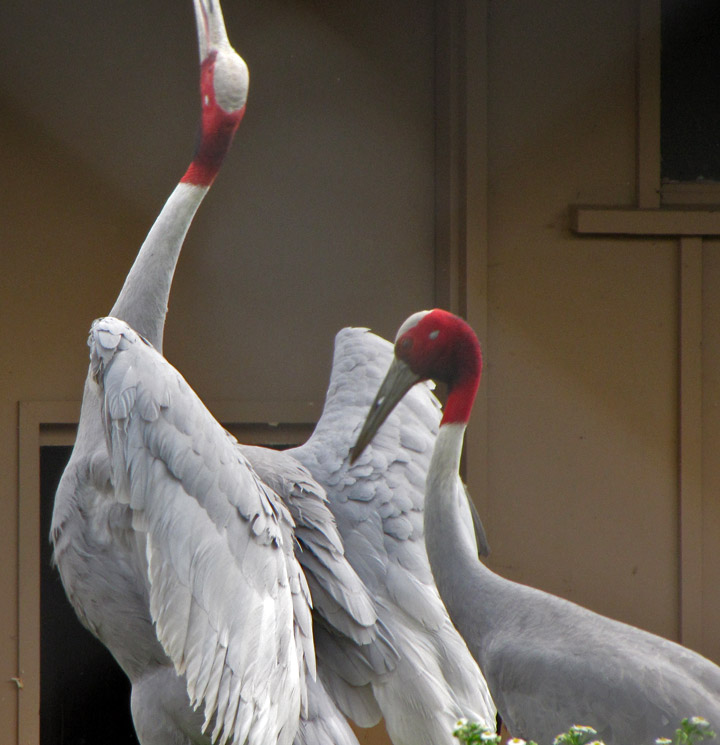
Whether these forms are all well-established subspecies is somewhat disputed.
Thorough mtDNA analyses, although hampered by the small number of available
specimens, suggest that the continental Asian populations had ongoing gene flow
until the 20th century range reductions, and that Australia was colonized by
this species only in the Late Pleistocene, some 35.000 years ago. This has been
corroborated by nDNA microsatellite analyses with 4 times the sample size. This
study further suggests that the Australian population is quite inbred. As there
exists the possibility of (limited) hybridization with the genetically quite
distinct Brolga, the Australian Sarus Crane can be expected to be an incipient
species and that the three major surviving populations should be considered as
"Evolutionary Significant Units".
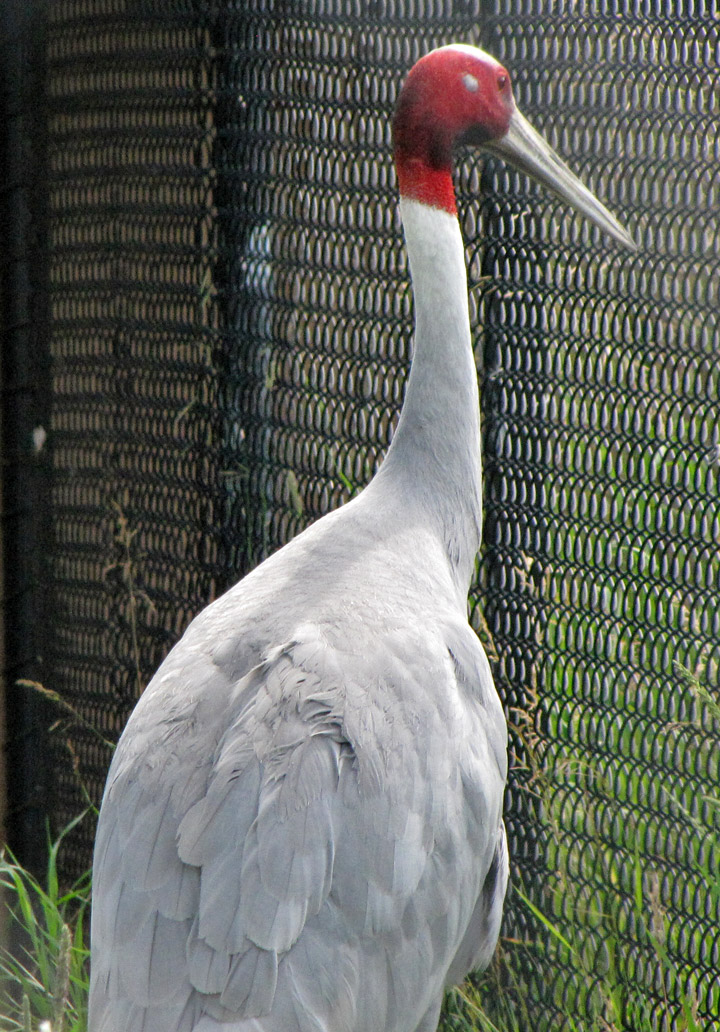
The common name of sarus is from the Hindi name (sāras) for the crane. The Hindi
word is derived from the Sanskrit word sarasa for the "lake bird", (sometimes
corrupted to sārhans). British soldiers in colonial India hunted the bird,
calling it the serious. The species name of antigone, after the daughter of
Oedipus, who hung herself may be related to the bare skin of the neck.
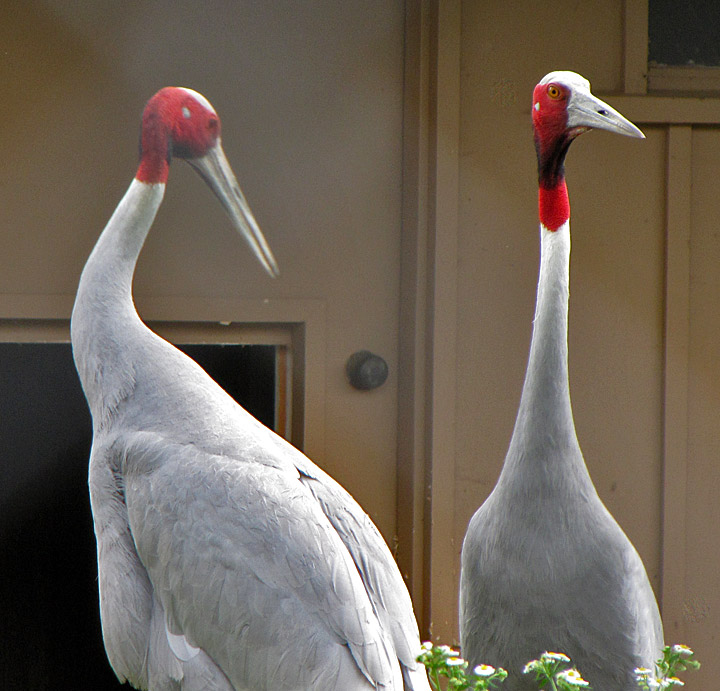
Unlike many cranes which make long migrations, the Sarus Crane does not; they
may however make short-distance dispersal movements in response to rain or dry
weather conditions. They tend to be more gregarious in the non-breeding season.
A study in the 29 km2 Keoladeo National Park noted as many as 300 birds during
summer and only about 30 resident during the breeding season.
These birds are usually seen in pairs or small groups of 2-5 and they forage in
shallow water (usually with less than 1 foot depth of water) or in fields,
sometimes probing in mud with their long bills. Larger flocks of up to 200 are
sometimes noted especially in some parts of the range such as in Gujarat and
Australia. They are omnivorous, eating insects (especially grasshoppers),
aquatic plants, fish (particularly perhaps in captivity), frogs, crustaceans and
seeds. Plants include tubers, corms of aquatic plants, grass shoots. They may
also feed on cultivated crops such as groundnuts and cereal crops such as rice.
They may also tackle vertebrate prey such as watersnakes (Xenochrophis piscator).
They have been known to take the eggs of other birds.
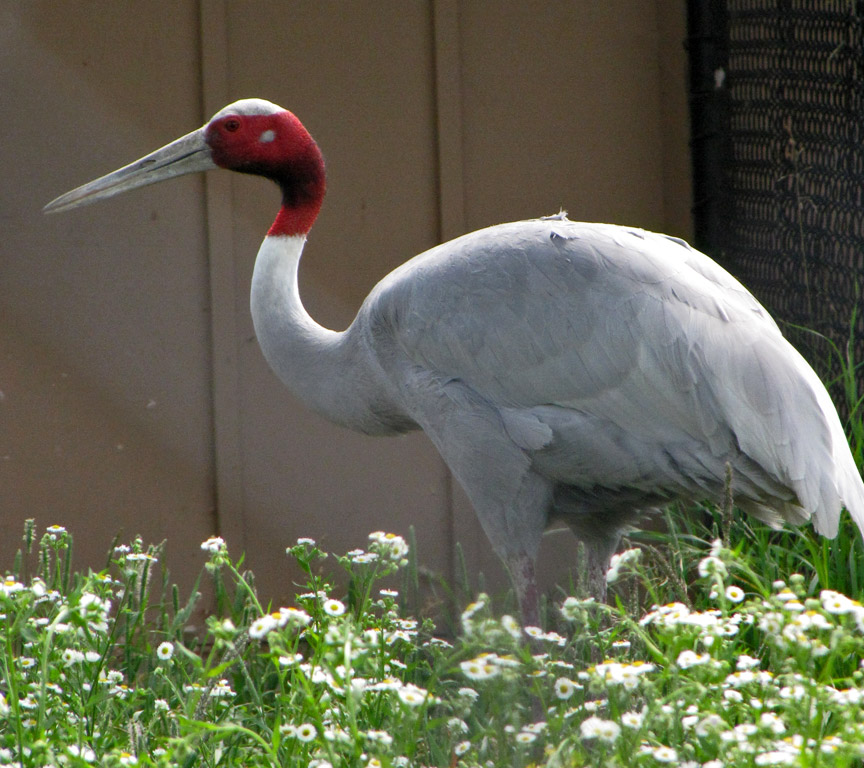
Sarus Cranes are known for their loud trumpeting calls. The loud trumpeting
calls are like in other cranes possible by the elongated trachea that form coils
within the sternal region. Pairs may indulge in spectacular displays of calling
in unison and posturing. These include "dancing" movements that are performed
both during and outside the breeding season and involve a short series of
jumping and bowing or going in circles. Dancing may also be shown as a
displacement activity when the nest or young are threatened. They breed during
the monsoons in India (from July to October although there may be a second brood
and there are records of breeding at other times of the year-May and February),
and with the onset of the wet season in Australia. They build a large nests,
platforms made of reeds and vegetation in wet marshes or paddy fields. The
platform nests can be more than two metres in diameter and nearly a meter high.
Pairs shows high fidelity to the nest site often reusing nests over as many as
five years. The clutch is 1 or 2 eggs (rarely 3) which are incubated by both
sexes for about 31 days (range 27-35 days). Eggs are chalky white and weigh
about 240 grams. The eggshells are removed by the parents after the chicks hatch
either by carrying away the fragments or by swallowing them. Chicks stay along
with their parents for a long duration of more than three months.
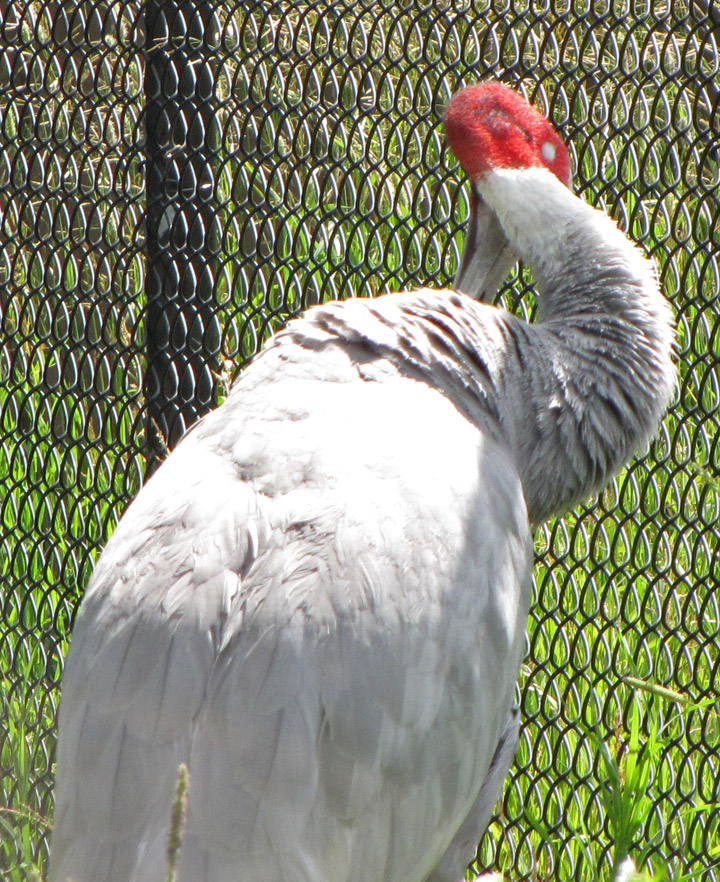
Eggs are often destroyed at the nest by Jungle Crows and House Crows. In
Australia, predators of young birds include the dingo (Canis dingo) and fox (Vulpes
vulpes) while Brahminy Kites have been known to take eggs. Trampling of eggs at
the nest is a a threat in agricultural areas in India. Chicks are also prone to
predation (estimated at about 8% but more than 30% die of unknown reasons).
Breeding success has been estimated at about 20%.
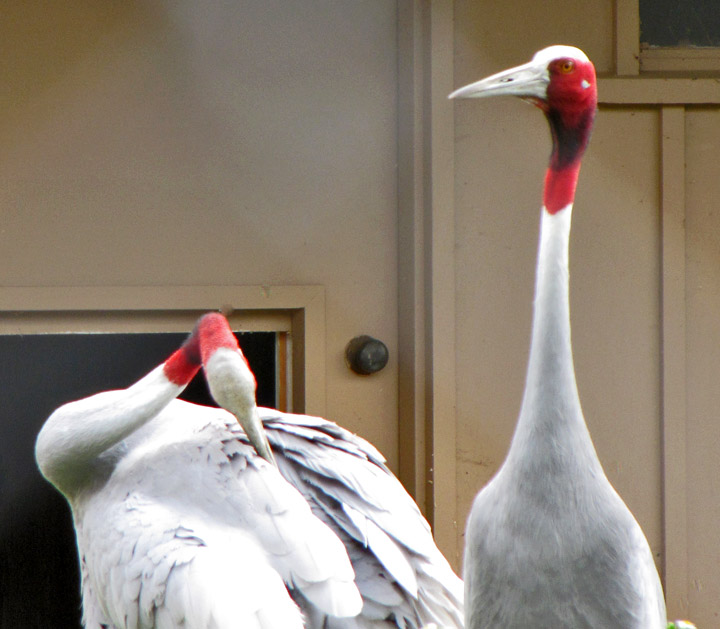
Adult mortality is mainly from human actions. Accidental poisoning by
monocrotophos and dieldrin treated seeds used in agricultural areas has been
noted. Adults have been known to fly into power lines and die of electrocution
and are considered a significant threat. Cranes in captivity have been known to
live for as long as 42 years.
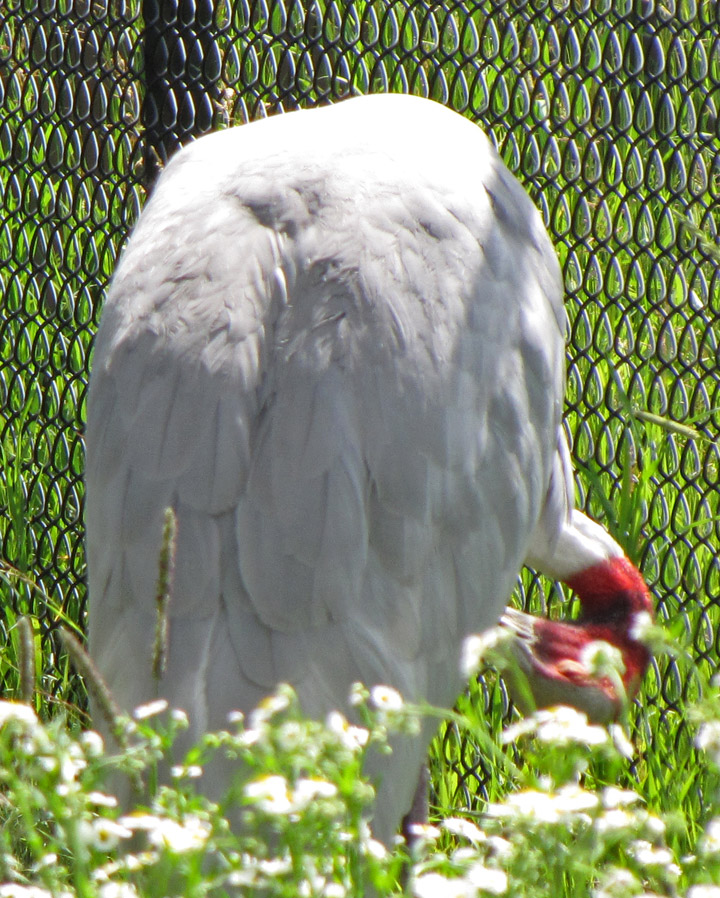
There were about an estimated 15-20,000 mature Sarus Cranes left in the wild in
2009. The Indian population is less than 10,000 birds but is the strongest
population. They are considered sacred and the birds are traditionally left
unharmed and in many areas they are unafraid of humans. They used to be found on
occasion in Pakistan, but not seen since the late 1980s. The population has
however declined. Estimates of the global population suggest that the population
in 2000 was at best about 10% and at the worst just 2.5% of the numbers that
existed in 1850. Many farmers in India believe that these crane damage standing
crops, particularly rice, although studies show that direct feeding on rice
grains resulted in losses amounting to less than 1 percent and trampling could
account for grain loss of about 0.4-15 kilograms. The attitude of farmers tends
to be positive in spite of these damages and this has helped in conserving the
species within agricultural areas. Compensating farmers for crop losses has been
suggested as a measure that may help. The Australian population is higher than
5,000 birds and may be increasing, however, the Southeast Asian subspecies has
been decimated by war and habitat modification and destruction (such as
intensive agriculture and draining of wetlands) and by the mid-20th century had
disappeared from large parts of its range which once stretched up to southern
China; some 1500–2000 birds are left in several fragmented subpopulations. The
little-known Philippine population became extinct in the late 1960s.
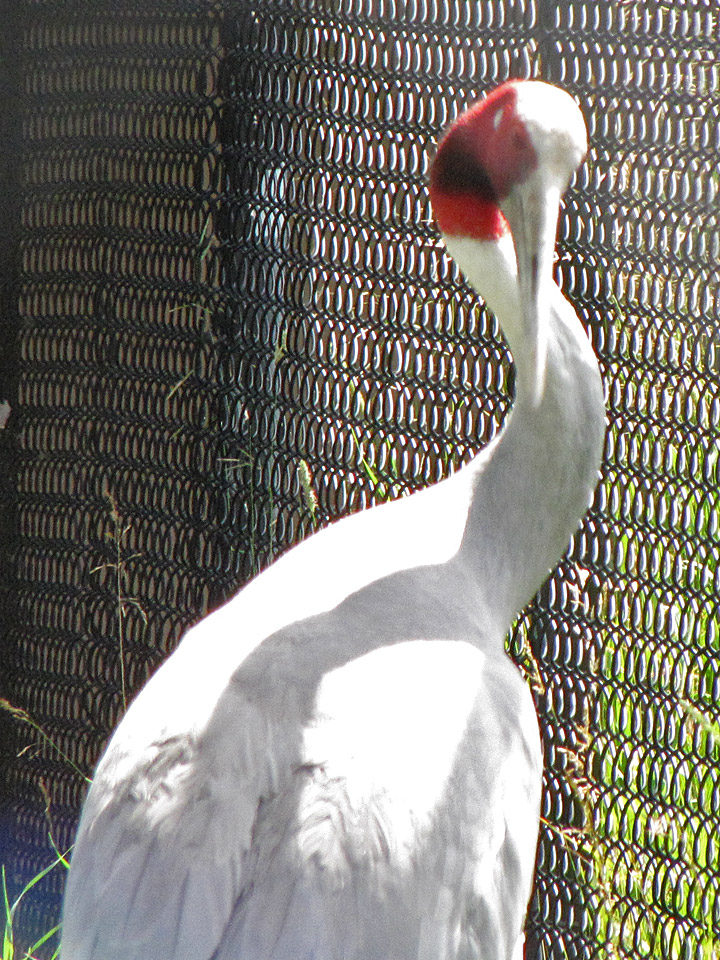
As a species, the Sarus crane is classified as Vulnerable (A2cde + 3cde). This means that the global population has declined by about a third since 1980, and is expected to continue to do so until the late 2010s. Threats constitute habitat destruction and/or degradation, hunting and collecting, as well as environmental pollution and possibly diseases or competing species. Inbreeding effects should be monitored in the Australian population.
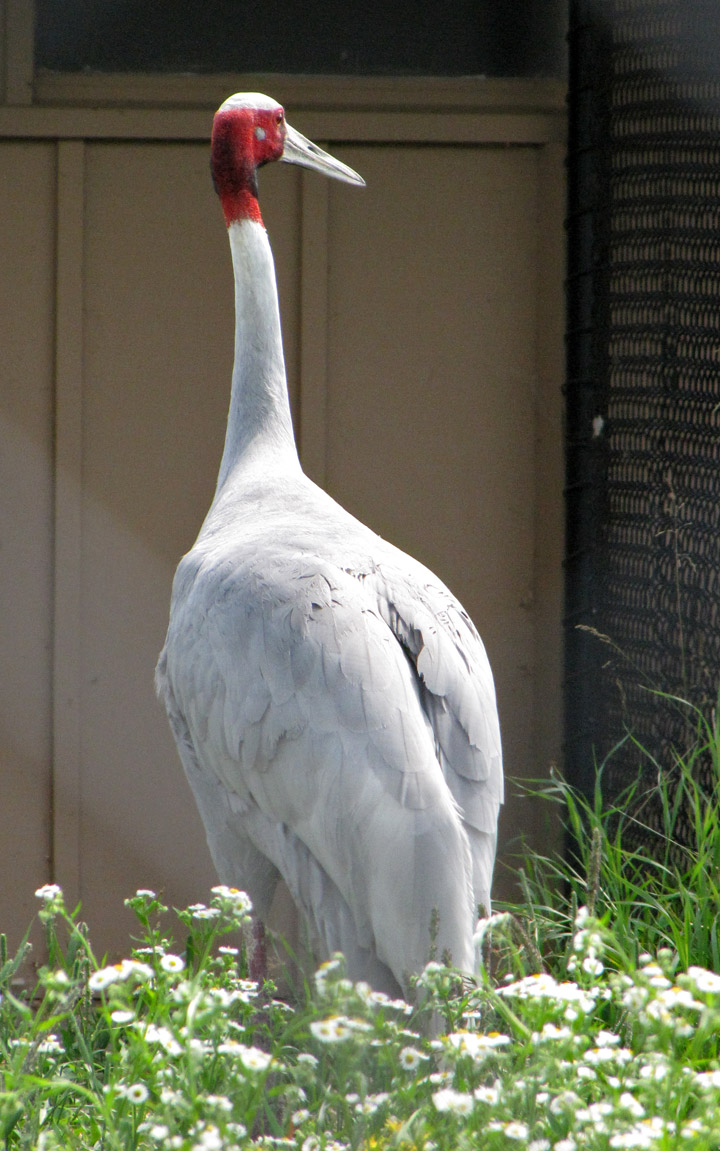
The species has been extirpated in Malaysia, Philippines and Thailand. Reintroduction programs planned in Thailand have made use of birds from Cambodia.
Text from Wikipedia